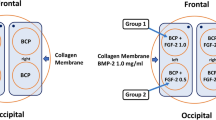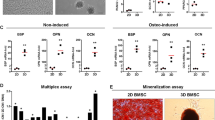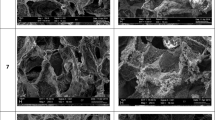Abstract
The three-dimensional (3D) plotting system is a rapidly-developing scaffold fabrication method for bone tissue engineering. It yields a highly porous and inter-connective structure without the use of cytotoxic solvents. However, the therapeutic effects of a scaffold fabricated using the 3D plotting system in a large segmental defect model have not yet been demonstrated. We have tested two hypotheses: whether the bone healing efficacy of scaffold fabricated using the 3D plotting system would be enhanced by bone marrow-derived mesenchymal stem cell (BMSC) transplantation; and whether the combination of bone morphogenetic protein-2 (BMP-2) administration and BMSC transplantation onto the scaffold would act synergistically to enhance bone regeneration in a large segmental defect model. The use of the combined therapy did increase bone regeneration further as compared to that with monotherapy in large segmental bone defects.







Similar content being viewed by others
References
Bretland AJ, Lawry J, Sharrard RM (2001) A study of death by anoikis in cultured epithelial cells. Cell Prolif 34:199–210
Cook SD, Salkeld SL, Patron LP, Sargent MC, Rueger DC (2002) Healing course of primate ulna segmental defects treated with osteogenic protein-1. J Invest Surg 15:69–79
Fedorovich NE, De Wijn JR, Verbout AJ, Alblas J, Dhert WJ (2008) Three-dimensional fiber deposition of cell-laden, viable, patterned constructs for bone tissue printing. Tissue Eng Part A 14:127–133
Haynesworth SE, Goshima J, Goldberg VM, Caplan AI (1992) Characterization of cells with osteogenic potential from human marrow. Bone 13:81–88
Kang SW, La WG, Kang JM, Park JH, Kim BS (2008a) Bone morphogenetic protein-2 enhances bone regeneration mediated by transplantation of osteogenically undifferentiated bone marrow-derived mesenchymal stem cells. Biotechnol Lett 30:1163–1168
Kang SW, Lee JS, Park MS, Park JH, Kim BS (2008b) Enhancement of in vivo bone regeneration efficacy of human mesenchymal stem cells. J Microbiol Biotechnol 18:975–982
Kang SW, Kim JS, Park KS, Cha BH, Shim JH, Kim JY, Cho DW, Rhie JW, Lee SH (2011a) Surface modification with fibrin/hyaluronic acid hydrogel on solid-free form-based scaffolds followed by BMP-2 loading to enhance bone regeneration. Bone 48:298–306
Kang SW, Lee SJ, Kim JS, Choi EH, Cha BH, Shim JH, Cho DW, Lee SH (2011b) Effect of a scaffold fabricated thermally from acetylated PLGA on the formation of engineered cartilage. Macromol Biosci 11:267–274
Katagiri T, Yamaguchi A, Ikeda T, Yoshiki S, Wozney JM, Rosen V, Wang EA, Tanaka H, Omura S, Suda T (1990) The nonosteogenic mouse pluripotent cell line, C3H10T1/2, is induced to differentiate into osteoblastic cells by recombinant human bone morphogenetic protein-2. Biochem Biophys Res Commun 172:295–299
Lo H, Ponticiello MS, Leong KW (1995) Fabrication of controlled release biodegradable foams by phase separation. Tissue Eng 1:15–28
Mikos AG, Sarakinos G, Leite SM, Vacanti JP, Langer R (1993) Laminated three-dimensional biodegradable foams for use in tissue engineering. Biomaterials 14:323–330
Mooney DJ, Park S, Kaufmann PM, Sano K, McNamara K, Vacanti JP, Langer R (1995) Biodegradable sponges for hepatocyte transplantation. J Biomed Mater Res 29:959–965
Park S, Kim G, Jeon YC, Koh Y, Kim W (2008) 3D polycaprolactone scaffolds with controlled pore structure using a rapid prototyping system. J Mater Sci Mater Med 20:229–234
Park SA, Lee SH, Kim WD (2011) Fabrication of porous polycaprolactone/hydroxyapatite (PCL/HA) blend scaffolds using a 3D plotting system for bone tissue engineering. Bioprocess Biosyst Eng 34:505–513
Perren SM (2002) Evolution of the internal fixation of long bone fractures. The scientific basis of biological internal fixation: choosing a new balance between stability and biology. J Bone Joint Surg Br 84:1093–1110
Petite H, Viateau V, Bensaid W, Meunier A, de Pollak C, Bourguignon M, Oudina K, Sedel L, Guilemin G (2000) Tissue-engineered bone regeneration. Nat Biotechnol 18:959–963
Quarto R, Mastrogiacomo M, Cancedda R, Kutepov SM, Mukhache V, Lavroukov A, Kon E, Marcacci M (2011) Repair of large bone defects with the use of autologous bone marrow stromal cells. N Engl J Med 344:385–386
Seeherman HJ, Azari K, Bidic S, Rogers L, Li XJ, Hollinger JO, Wozney JM (2006) rhBMP-2 delivered in a calcium phosphate cement accelerates bridging of critical-sized defects in rabbit radii. J Bone Joint Surg Am 88:1553–1565
Shim JH, Kim JY, Park JK, Hahn SK, Rhie JW, Kang SW, Lee SH, Cho DW (2010) Effect of thermal degradation of SFF-based PLGA scaffolds fabricated using a multi-head deposition system followed by change of cell growth rate. J Biomater Sci Polym Ed 21:1069–1080
Wang G, Yang H, Li M, Lu S, Chen X, Cai X (2010) The use of silk fibroin/hydroxyapatite composite co-cultured with rabbit bone-marrow stromal cells in the healing of a segmental bone defect. J Bone Joint Surg Br 92:320–325
Zhu XH, Lee LY, Jackson JS, Tong YW, Wang CH (2008) Characterization of porous poly(D, L-lactic-co-glycolic acid) sponges fabricated by supercritical CO2 gas-foaming method as a scaffold for three-dimensional growth of Hep3B cells. Biotechnol Bioeng 100:998–1009
Acknowledgments
This work was supported by the grant (KRF-2008-313-E00356) from the National Research Foundation of Korea.
Author information
Authors and Affiliations
Corresponding author
Additional information
Sun-Woong Kang and Ji-Hoon Bae contributed equally to this work.
Rights and permissions
About this article
Cite this article
Kang, SW., Bae, JH., Park, SA. et al. Combination therapy with BMP-2 and BMSCs enhances bone healing efficacy of PCL scaffold fabricated using the 3D plotting system in a large segmental defect model. Biotechnol Lett 34, 1375–1384 (2012). https://doi.org/10.1007/s10529-012-0900-0
Received:
Accepted:
Published:
Issue Date:
DOI: https://doi.org/10.1007/s10529-012-0900-0




